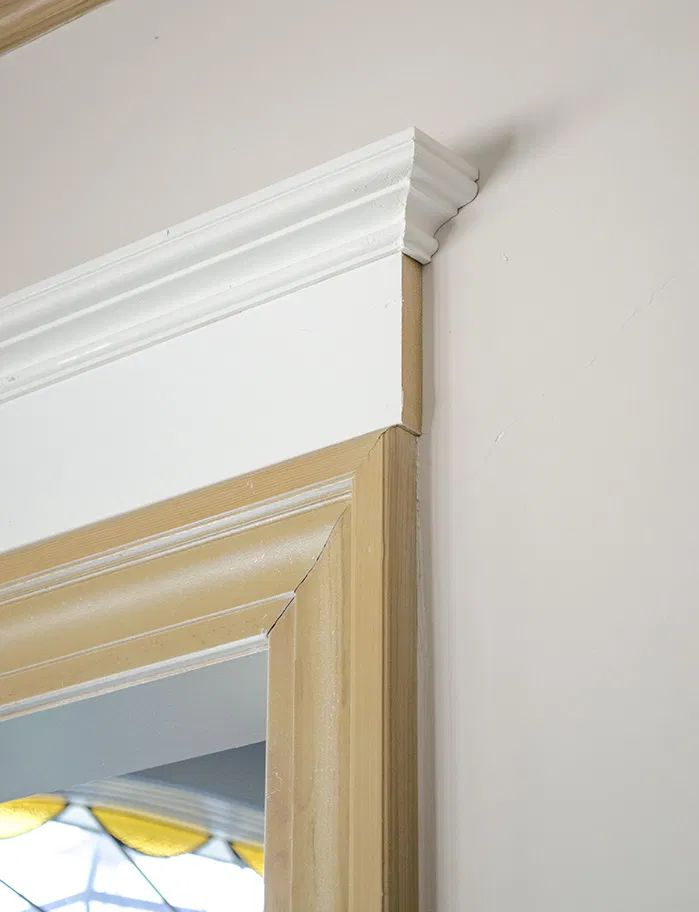Crown molding, a timeless architectural feature, has adorned homes and buildings for generations. This refined trim, positioned at the junction of walls and ceilings, brings an air of sophistication to any space. As we progress through 2024, crown molding remains a favored choice among homeowners and designers aiming to enhance interior aesthetics. The craft of crown molding installation demands expertise, accuracy, and a keen eye for detail. This article explores the nuances of crown molding installation, providing valuable insights into the methods, materials, and techniques employed by industry professionals.
The History and Evolution of Crown Molding
Crown molding’s roots trace back to ancient Greece and Rome, where artisans carved these decorative elements from stone and wood to add visual interest to buildings. Over centuries, crown molding designs evolved, becoming more varied and refined. In 2024, crown molding offers a wide array of materials, styles, and sizes, accommodating diverse architectural preferences.
During the 18th and 19th centuries, crown molding became a signature feature in upscale residences, particularly in Victorian and Georgian architecture. The Industrial Revolution’s mass production techniques made crown molding more affordable and widely available, allowing homeowners across social classes to incorporate this elegant detail into their living spaces.
As we progress through 2024, crown molding continues to adapt to modern aesthetics while preserving its timeless appeal. Contemporary designs often showcase clean lines and minimalist profiles, aligning with the current trend of sleek, uncluttered interiors. Simultaneously, traditional and ornate styles maintain their popularity, especially in period restorations and homes aiming for a classic ambiance.
Selecting the Ideal Crown Molding
Selecting crown molding involves a thoughtful process that takes into account your home’s unique characteristics. The architectural style, ceiling height, and overall design theme play pivotal roles in determining the perfect crown molding for your space. Let’s explore the key aspects to consider when making your selection:
Materials: Crown molding offers a variety of options, each with its own set of advantages. Wood remains a popular choice due to its classic appeal and versatility, allowing for customization through painting or staining to match any interior. Those looking for a cost-effective solution might prefer medium-density fiberboard (MDF), which is user-friendly and takes paint well. For moisture-prone areas like bathrooms, polyurethane molding proves to be a durable and warp-resistant option.
Dimensions and Shape: The scale of your crown molding should complement the room’s proportions. Spacious rooms with high ceilings can accommodate larger, more decorative moldings, while rooms with lower ceilings are better suited to simpler, narrower profiles. The shape of the molding should harmonize with the existing architectural features and furniture styles in the room.
Surface Treatment: The finish of your crown molding plays a significant role in defining the room’s atmosphere. Painted moldings offer a crisp, clean appearance and can be color-coordinated with walls or ceilings for a seamless look. Natural wood finishes bring warmth and texture to the space. For those seeking something unique, metallic or faux finishes on crown molding can add a distinctive flair to the room.
Cohesion with Other Elements: When selecting crown molding, it’s crucial to consider how it will integrate with other trim work in the room, such as baseboards, door frames, and window casings. Creating a unified look across all these elements results in a well-coordinated and refined interior design.
Preparing for Installation
Setting the stage for a flawless crown molding installation requires careful planning and preparation. This crucial phase lays the groundwork for a smooth and efficient process, ensuring that your project starts on the right foot.
Room Assessment: Begin with a thorough examination of the space. Take note of any wall or ceiling irregularities that might impact the installation. Identify potential obstacles like light fixtures, vents, or existing trim that may require special attention.
Precise Measurements: Accuracy is key when measuring the installation area. Measure each wall where the molding will be placed, accounting for corners and angles. Add a small buffer to your measurements to allow for adjustments during the installation process.
Tool Preparation: Gather all necessary equipment before starting. A well-stocked toolbox for crown molding installation typically includes a miter saw, coping saw, nail gun, level, measuring tape, and caulk gun. Having these tools ready prevents unnecessary interruptions.
Material Acclimation: For wood molding, allow the material to adjust to the room’s environment for at least 24 hours prior to installation. This step helps minimize potential warping or shrinking after the molding is in place.
Surface Preparation: Ensure that walls and ceilings are clean, dry, and in good condition. Address any cracks or holes, and smooth out rough spots. If you plan to paint the molding, it’s often more convenient to do so before installation, with touch-ups applied afterwards.
Safety First: Create a safe work environment with adequate lighting and ventilation. When operating power tools, always use appropriate safety equipment, including eye and ear protection.
The Installation Process
Crown molding installation is an art that demands skill and precision. Professional craftsmen make it look effortless, but the process involves several key steps that require careful attention:
Cutting and Measuring: Corners present the biggest challenge in crown molding installation. Inside corners call for coped joints, while outside corners use mitered joints. A miter saw, set to the proper angle (typically 45 degrees for standard crown molding), is essential for these cuts. The old carpenter’s adage of measuring twice and cutting once is particularly relevant here.
Dry Fitting: Before permanent attachment, each piece should be dry fitted. This crucial step allows for any necessary adjustments, ensuring a perfect fit when the molding is finally secured.
Attachment: With the pieces cut and fitted, it’s time for installation. A nail gun is used to secure the molding, with nails placed at regular intervals along both the top and bottom edges. Care must be taken to avoid splitting the wood by nailing too close to the edges.
Joining Pieces: Long walls often require multiple pieces of molding. Scarf joints, created by cutting the ends of the molding at matching angles, allow for seamless joining. These joints are best placed in less conspicuous areas of the room.
Coping Inside Corners: For a flawless finish on inside corners, a coping saw is used to cut along the profile of one piece of molding. This allows it to fit snugly against the face of the adjoining piece.
Filling and Finishing: Post-installation, any nail holes and gaps are filled with wood filler or caulk. Once dry, these areas are sanded smooth. If the molding wasn’t pre-painted, this is when paint or stain is applied to achieve the desired finish.
Dealing with Challenges
Crown molding installation can present obstacles, even for seasoned professionals. Older homes often have walls or ceilings that aren’t perfectly straight. Use flexible caulk to fill gaps, or scribe the molding for a custom fit in extreme cases.
When rooms deviate from standard 90-degree corners, an angle finder becomes your best friend. For complex cuts, creating templates can save time and materials.
Adding to existing molding or replacing damaged sections can be tricky. If you can’t find an exact match, consider a full replacement for a cohesive look.
Each type of crown molding behaves differently. MDF requires a fine-toothed saw to prevent chipping, while polyurethane needs expansion gaps to accommodate temperature changes.
Crown Molding in Modern Design
Crown molding, a classic architectural element, is finding new life in contemporary interiors. In 2024, designers are reimagining this traditional feature with fresh approaches that blend seamlessly with modern aesthetics.
Sleek, minimalist profiles are gaining traction in contemporary homes. These clean lines complement modern architecture, adding subtle sophistication without overwhelming the space. Some homeowners are opting for crown molding with integrated LED lighting, creating a soft, ambient glow that adds a contemporary touch to rooms.
Color is another area where crown molding is breaking tradition. Moving beyond classic white, designers are using bold, contrasting hues to turn this architectural detail into a striking accent feature. This approach adds visual interest and can dramatically alter a room’s atmosphere.
Material innovation is also at the forefront of modern crown molding design. By combining different materials, such as wood with metal inlays, designers are creating unique, eye-catching elements that serve as artistic features in their own right. Textured finishes and patterns are becoming more prevalent, adding depth and interest to walls without the need for additional decorative elements.
The Impact of Crown Molding on Home Value
Crown molding can boost a home’s value, often cited by real estate professionals as a desirable feature that distinguishes properties in the market. It signifies quality construction and meticulous attention to detail, appealing to potential buyers.
The value added by crown molding is influenced by several factors. Professional installation is key, as poorly executed work can diminish rather than enhance a home’s worth. The style and scale should complement the home’s architecture and overall design, avoiding mismatches like ornate molding in minimalist spaces.
Consistency plays a role too. Crown molding used throughout main living areas tends to have a greater impact than isolated installations. Market preferences also come into play, with some regions valuing this feature more highly than others.
Maintenance and Care
Crown molding, while low-maintenance, benefits from occasional attention to preserve its elegance. A gentle dusting with a soft cloth keeps it pristine, while painted surfaces may require a mild soap solution for deeper cleaning. Over time, touch-ups with matching paint can address minor chips or scuffs, maintaining a fresh appearance.
Regular inspections help catch and address any separation from walls or ceilings early, preventing further issues. In humid areas, maintaining consistent indoor climate helps preserve wood molding’s integrity. When finishes wear or styles change, refinishing offers a cost-effective alternative to replacement, breathing new life into your crown molding.
The Future of Crown Molding
Crown molding is poised for an exciting future, with emerging technologies and materials reshaping its possibilities. 3D printing is opening doors to customized designs that fit perfectly in any space, even those with unusual angles or curves. The green building movement is influencing the industry too, with new eco-friendly options made from recycled or sustainable materials gaining traction.
In the realm of smart homes, crown molding is finding new purpose. Imagine trim that doubles as a discreet housing for speakers or environmental controls, seamlessly blending form and function. Some forward-thinking manufacturers are even exploring modular systems, allowing for easier installation and adaptation to changing tastes or needs.
These advancements promise to keep crown molding relevant and desirable in modern interiors, proving that even classic architectural elements can evolve with the times.
Crafting Timeless Elegance

Crown molding seamlessly blends classic charm with contemporary design, offering a versatile finishing touch to any interior. From historic renovations to modern spaces, it provides endless opportunities to enhance your home’s aesthetic appeal. Success in crown molding installation comes from meticulous planning and expert execution.
For Indianapolis homeowners seeking to perfect their interiors with crown molding, Radford Woodworks offers unmatched expertise. Our skilled team excels in material selection and installation, ensuring your vision comes to life flawlessly.
Ready to elevate your home’s interior? Reach out to Radford Woodworks at 317-739-8555 or visit https://radfordwoodworks.com/contact/ to get a quote. Let’s collaborate to create the perfect crown molding for your space.






